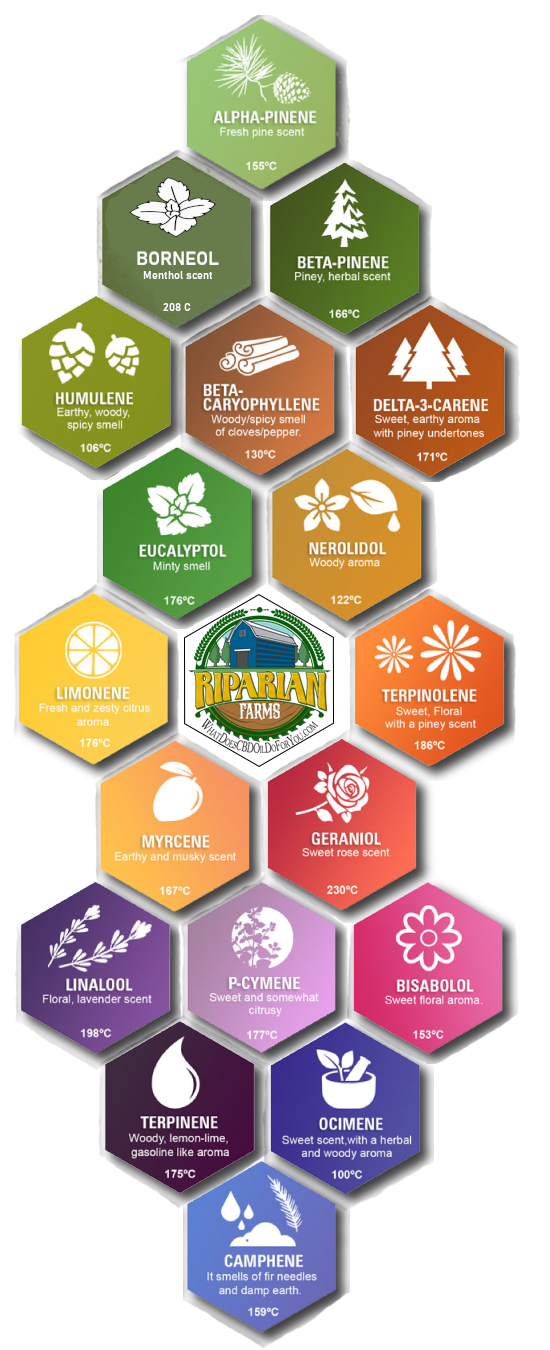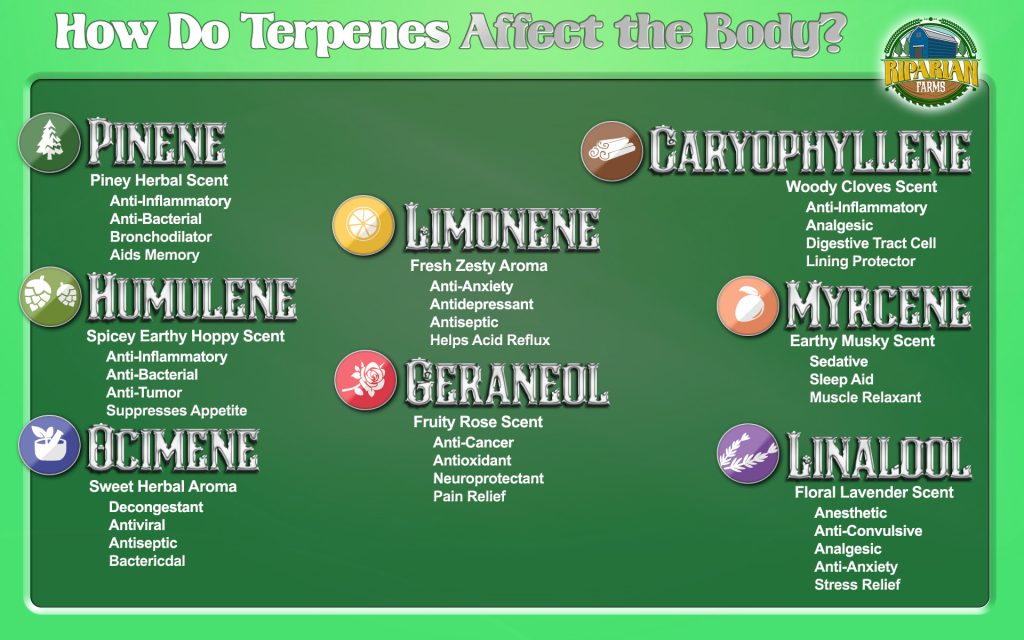Terpenes: What You Need to Know

Terpenes are the largest category and most diverse group of naturally occurring aromatic compounds found in the plants of God’s green earth. Over 800 different terpenes, with more than 15,000 terpenoids (a.k.a. isoprenoids or combinations of two or more terpenes or naturally occurring chemicals) have been discovered. You can find them in all sorts of plants which give them their aroma and probably have experienced their scents with any essential oil on the market. Terpenes are a hydrocarbon, which means they are made up of just carbon and hydrogen. Terpenoids, on the other hand are denatured or chemically modified via a curing or drying process.
If you have ever come across any essential oils type of product from the three or four major companies out in the marketplace, you have smelled a terpene. A major selling point of these types of aromatic products are their aromas, which can assist in the desired therapeutic end result someone using their products seek to have. It is not limited to oils manufactured by these companies, any product derived from a plant that has its corresponding aroma (perfumes, cleaners, finishes, even potpourri) has a terpene element to it.
SIMPLY PUT:
Terpenes are the essential oils made by all plants. Terpenes are what give each flower, herb, fruit, and extract it’s own unique scent, flavor and effect.
Everyday, everywhere you go, you encounter terpenes, they make life exciting. When you zest a lemon…you smell terpenes. Open a jar full of herb…what you are smelling is the terpenes. Stop and smell the roses? More like stop and smell the terpenes.
While there is so much you CAN learn, what you NEED to know is that terpenes are scented molecules that when inhaled, applied to the skin, or consumed affect how we feel.
A BIT MORE COMPLEX:
Terpenes are the most basic essential oils produced in nature; in total over 30,000 have been identified. Plants, animals, microbes, and fungi produce terpenes to carry out necessary biological functions. This diverse class of compounds serve as vitamins, hormones, pheromones, and as part of the immune system.
One way to think of terpenes is as building blocks which come together to make complex essential oils, these building blocks are created by plants and combined in countless ways in order to produce full plant essential oils like Lavender, Rose, Sandalwood, Kush, Tangie, and Durban Poison.
Though scent is what they are known for, terpenes play an equally important role in influencing how we will feel when we consume an herb, fruit, or flower. This is because they act synergistically with other botanical compounds and our own native hormones – acting on the same neurons in the brain; this phenomenon is known as the entourage effect.
What are they used for?
SIMPLY PUT:
Terpenes can be added to herbs, extracts, and manufactured products before use in order to enhance the effect and improve the scent or flavor.
A BIT MORE COMPLEX:
While nature has its own uses for them, humans have found many diverse applications for terpenes; both in isolation and as part of complex blends. It might surprise you to know that terpenes are used in the development of food flavorings, incense, cosmetic products, organic gardening products, household cleaners, natural medicines, and perfumes.
In the past few years, product manufacturers have used isolated terpenes in order to reverse engineer the terpene profile of popular herbs; this blend is then introduced to a formulation in order to mimic the scent, flavor.
 How do I use them?
How do I use them?
A little at a time – Terpenes can be added to aromatherapy blends, diffusers, lotions, edibles, tinctures, cocktails, homemade cleaners, bug repellents, plant extracts, and generally used as you might an essential oil.
A LITTLE GOES A LOOOONNGG WAY!
Terpenes are POTENT and should never be consumed, inhaled, or applied to the skin before being diluted.
Certain terpenes are more potent than others and they must be handled with care. When using isolated terpenes be sure to use the appropriate skin protection, eye protection and operate in a well ventilated area.
In most cases you will want to stay within 1-5% concentration by volume but can vary depending on the isolated terpene, blend, person, and desired effects.
Where do your terpenes come from?
Our terpenes are derived from many different, all natural sources. There are over 30,000 terpenes in nature and they are not unique to only one species of plant.
For example, alpha pinene is the most prevalent terpene and can be found in thousands of different plants. The molecules themselves are identical no matter what plant they come from. Some people argue about the importance of the source of the terpenes but once the molecules are isolated, there is virtually no difference.
Our terpenes are extracted via steam, expression, or cryogenic methods and fractionally distilled for purity.
High purity warning labels
There are extensive warning labels high concentration terpene products because they can be dangerous at high purities. Each terpene has different properties and needs to be handled accordingly. With the proper dilution, our terpenes can be used in many different applications.
The terpene isolates out on the market today are usually concentrates or distillates extracted through a mechanical distillation process.
It is worthy of noting that if a pure concentration of a terpene is to be handled, it should be with care! At high concentrations, terpenes can be dangerous if handled correctly. You need to have it diluted or added to another tincture utilizing a safe method of doing so.
Also worthy of noting is that terpenes, as well as the different CB compounds i.e. CBD, CBG, CBC, CBDA etc. are non-psychoactive and have proven medicinal value.
Commonly sold (here in particular) as concentrates in glass bottles with dropper caps terpenes have serious therapeutic power. Combine CBD with the right levels of beta caryophellene for anti-inflammatory and arthritis relief can have what they call an ‘entourage’ affect on what you want to take care of. You must make sure that you properly seal the container in which you store your choice of terpene, because they can diminish over the course of time exposed to the air.


